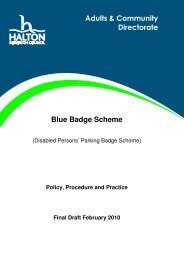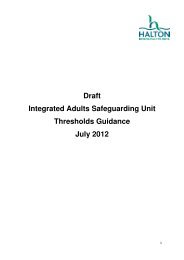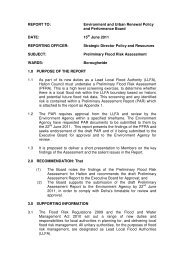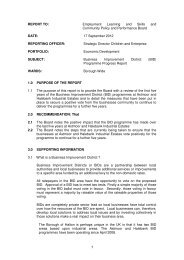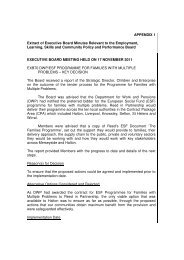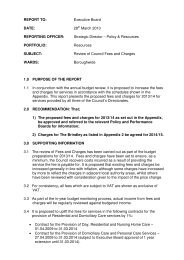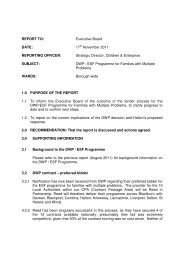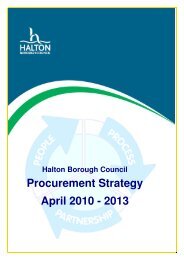Transport Asset Management Plan - Halton Borough Council
Transport Asset Management Plan - Halton Borough Council
Transport Asset Management Plan - Halton Borough Council
Create successful ePaper yourself
Turn your PDF publications into a flip-book with our unique Google optimized e-Paper software.
<strong>Halton</strong> <strong>Borough</strong> <strong>Council</strong><br />
<strong>Transport</strong> <strong>Asset</strong> <strong>Management</strong> <strong>Plan</strong><br />
A lifecycle plan will document how each phase of the asset’s life is managed, from creation to<br />
disposal.<br />
It will recognise how the level of investment in say, routine maintenance affects the<br />
renewals required. The Options available are shown in Table 16 below: -<br />
Table 16 <strong>Asset</strong> Lifecycle Options<br />
<strong>Asset</strong>s are created or acquired in response to one of three demands:-<br />
Development – Where existing assets are improved and new assets are created<br />
Creation or as part of new developments.<br />
Acquisition<br />
(Build or<br />
Capacity – Where the current system is operating above its capacity one potential<br />
solution is the creation of new assets. A simplistic example would be the widening<br />
purchase a of a road to allow for increased traffic.<br />
new asset) Performance – The explicit measurement of levels of service will lead to<br />
information on where levels of service are not being met. This may enable the<br />
identification of where additional asset capacity is required.<br />
Routine<br />
Maintenance<br />
carry out<br />
routine<br />
maintenance<br />
to maintain the<br />
asset in a<br />
serviceable<br />
condition<br />
Routine maintenance regimes are generally based on historic practices rather than<br />
identified needs. <strong>Asset</strong> management demands the explicit identification of need.<br />
This is achieved by answering the following questions:-<br />
Condition Monitoring:- Is the condition of the asset routinely measured?<br />
Routine Maintenance Standards: - What RMS are in place and have they been<br />
reviewed in relation to customer demands?<br />
Reactive Maintenance:- What level of activity exists?<br />
Maintenance / safety inspections: - Are the outputs from these inspections used<br />
to assess the effectiveness of RMS activities?<br />
Renewal or<br />
Replacement<br />
(Carry out work<br />
to return the<br />
asset to its “as<br />
new” capacity<br />
condition<br />
Renew or replace the whole asset, or elements of it.<br />
Renewals and replacements are the major treatments that are used when routine<br />
maintenance alone cannot sustain the asset. The identification of renewals /<br />
replacements and in particular the timing of such treatments is a fundamental<br />
element of lifecycle planning. This is achieved by answering the following<br />
questions: -<br />
• How are potential renewals identified?<br />
• How are renewals / replacements evaluated?<br />
• How is the linkage between routine maintenance and renewals evaluated?<br />
• How are the expected lives of treatments identified and checked?<br />
FinalversionLprovisional0.doc 45






